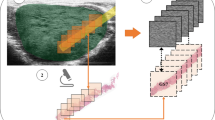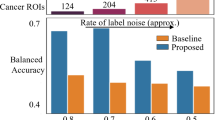Abstract
Purpose
Systematic prostate biopsy is widely used for cancer diagnosis. The procedure is blind to underlying prostate tissue micro-structure; hence, it can lead to a high rate of false negatives. Development of a machine-learning model that can reliably identify suspicious cancer regions is highly desirable. However, the models proposed to-date do not consider the uncertainty present in their output or the data to benefit clinical decision making for targeting biopsy.
Methods
We propose a deep network for improved detection of prostate cancer in systematic biopsy considering both the label and model uncertainty. The architecture of our model is based on U-Net, trained with temporal enhanced ultrasound (TeUS) data. We estimate cancer detection uncertainty using test-time augmentation and test-time dropout. We then use uncertainty metrics to report the cancer probability for regions with high confidence to help the clinical decision making during the biopsy procedure.
Results
Experiments for prostate cancer classification includes data from 183 prostate biopsy cores of 41 patients. We achieve an area under the curve, sensitivity, specificity and balanced accuracy of 0.79, 0.78, 0.71 and 0.75, respectively.
Conclusion
Our key contribution is to automatically estimate model and label uncertainty towards enabling targeted ultrasound-guided prostate biopsy. We anticipate that such information about uncertainty can decrease the number of unnecessary biopsy with a higher rate of cancer yield.




Similar content being viewed by others
References
Eichler K, Hempel S, Wilby J, Myers L, Bachmann LM, Kleijnen J (2006) Diagnostic value of systematic biopsy methods in the investigation of prostate cancer: a systematic review. J Urol 175(5):1605–1612
Hodge KK, McNeal JE, Stamey TA (1989) Ultrasound guided transrectal core biopsies of the palpably abnormal prostate. J Urol 142(1):66–70
Siddiqui MM, Rais-Bahrami S, Turkbey B, George AK, Rothwax J, Shakir N, Okoro C, Raskolnikov D, Parnes HL, Linehan WM, Merino MJ, Simon RM, Choyke PL, Wood BJ, Pinto PA (2015) Comparison of MR/ultrasound fusion-guided biopsy with ultrasound-guided biopsy for the diagnosis of prostate cancer mr/ultrasound fusion biopsy for prostate cancer MR/ultrasound fusion biopsy for prostate cancer. JAMA 313(4):390–397
Natarajan S, Marks LS, Margolis DJA, Huang J, Macairan ML, Lieu P, Fenster A (2011) Clinical application of a 3D ultrasound-guided prostate biopsy system. Urol Oncol 29(3):334–342
Ahmed HU, Bosaily AES, Brown LC, Gabe R, Kaplan R, Parmar MK, Collaco-Moraes Y, Ward K, Hindley RG, Freeman A, Kirkham AP, Oldroyd R, Parker C, Emberton M (2017) Diagnostic accuracy of multi-parametric MRI and TRUS biopsy in prostate cancer PROMIS: a paired validating confirmatory study. The Lancet 389(10071):815–822
Feleppa E, Porter C, Ketterling J, Dasgupta S, Ramachandran S, Sparks D (2007) Recent advances in ultrasonic tissue-type imaging of the prostate. In: Acoustical imaging. Springer, Berlin, pp 331–339
Correas JM, Tissier AM, Khairoune A, Khoury G, Eiss D, Hélénon O (2013) Ultrasound elastography of the prostate: state of the art. Diagn Interv Imaging 94(5):551–560
Moradi M, Mousavi P, Abolmaesumi P (2007) Tissue characterization using fractal dimension of high frequency ultrasound RF time series. Medical Image Computing and Computer-assisted Intervention, pp 900–908
Imani F, Abolmaesumi P, Gibson E, Khojaste A, Gaed M, Moussa M, Gomez JA, Romagnoli C, Leveridge M, Chang S, Siemens DR, Fenster A, Ward AD, Mousavi P (2015a) Computer-aided prostate cancer detection using ultrasound RF time series: in vivo feasibility study. IEEE Trans Med Imaging 34(11):2248–2257
Imani F, Zhuang B, Tahmasebi A, Kwak JT, Xu S, Agarwal H, Bharat S, Uniyal N, Turkbey IB, Choyke P, Wood B, Moradi M, Mousavi P, Abolmaesumi P (2015b) Augmenting MRI-transrectal ultrasound-guided prostate biopsy with temporal ultrasound data: a clinical feasibility study. Int J Comput Assist Radiol Surg 10(6):727–735
Nahlawi L, Imani F, Gaed M, Gomez JA, Moussa M, Gibson E, Fenster A, Ward AD, Abolmaesumi P, Mousavi P, Shatkay H (2015) Using hidden Markov models to capture temporal aspects of ultrasound data in prostate cancer. In: 2015 IEEE international conference on bioinformatics and biomedicine (BIBM), pp 446–449
Moradi M, Abolmaesumi P, Mousavi P (2010) Tissue typing using ultrasound RF time series: experiments with animal tissue samples. Med Phys 37(8):4401–4413
Bayat S, Azizi S, Daoud MI, Nir G, Imani F, Gerardo CD, Yan P, Tahmasebi A, Vignon F, Sojoudi S, Wilson S, Iczkowski KA, Lucia MS, Goldenberg L, Salcudean SE, Abolmaesumi P, Mousavi P (2017a) Investigation of physical phenomena underlying temporal-enhanced ultrasound as a new diagnostic imaging technique: theory and simulations. IEEE Trans Ultrason Ferroelectr Freq Control 65(3):400–410
Bayat S, Imani F, Gerardo CD, Nir G, Azizi S, Yan P, Tahmasebi A, Wilson S, Iczkowski KA, Lucia MS, Goldenberg L, Salcudean SE, Mousavi P, Abolmaesumi P (2017b) Tissue mimicking simulations for temporal enhanced ultrasound-based tissue typing. In: Medical imaging 2017: ultrasonic imaging and tomography, vol 10139. International Society for Optics and Photonics, pp 79–84
Sedghi A, Mehrtash A, Jamzad A, Amalou A, III WMW, Kapur T, Kwak JT, Turkbey B, Choyke P, Pinto P, Wood B, Xu S, Abolmaesumi P, Mousavi P (2020) Improving detection of prostate cancer foci via information fusion of MRI and temporal enhanced ultrasound. Int J Comput Assist Radiol Surg 15(7), 1215–1223
Javadi G, To MNN, Samadi S, Bayat S, Sojoudi S, Hurtado A, Chang S, Black P, Mousavi P, Abolmaesumi P (2020a) Complex cancer detector: Complex neural networks on non-stationary time series for guiding systematic prostate biopsy. In: International conference on medical image computing and computer-assisted intervention. Springer, Berlin, pp 524–533
Javadi G, Samadi S, Bayat S, Pesteie M, Jafari MH, Sojoudi S, Kesch C, Hurtado A, Chang S, Mousavi P, Abolmaesumi P (2020b) Multiple instance learning combined with label invariant synthetic data for guiding systematic prostate biopsy: a feasibility study. Int J Comput Assist Radiol Surg 15:1023–1031
Liao Z, Girgis H, Abdi A, Vaseli H, Hetherington J, Rohling R, Gin K, Tsang T, Abolmaesumi P (2019) On modelling label uncertainty in deep neural networks: automatic estimation of intra-observer variability in 2D echocardiography quality assessment. IEEE Trans Med Imaging 39(6):1868–1883
Esfeh MMK, Luong C, Behnami D, Tsang T, Abolmaesumi P (2020) A deep Bayesian video analysis framework: towards a more robust estimation of ejection fraction. In: International conference on medical image computing and computer-assisted intervention. Springer, Berlin, pp 582–590
Tajbakhsh N, Jeyaseelan L, Li Q, Chiang JN, Wu Z, Ding X (2020) Embracing imperfect datasets: a review of deep learning solutions for medical image segmentation. Medical Image Analysis p 101693
Venturini L, Papageorghiou AT, Noble JA, Namburete AI (2020) Uncertainty estimates as data selection criteria to boost omni-supervised learning. In: International conference on medical image computing and computer-assisted intervention. Springer, Berlin, pp 689–698
Karimi D, Dou H, Warfield SK, Gholipour A (2020) Deep learning with noisy labels: exploring techniques and remedies in medical image analysis. Med Image Anal 65:101759
Amiri M, Brooks R, Behboodi B, Rivaz H (2020) Two-stage ultrasound image segmentation using u-net and test time augmentation. Int J Comput Assist Radiol Surg 15(6):981–988
Wang G, Li W, Aertsen M, Deprest J, Ourselin S, Vercauteren T (2019) Aleatoric uncertainty estimation with test-time augmentation for medical image segmentation with convolutional neural networks. Neurocomputing 338:34–45
Cao X, Chen H, Li Y, Peng Y, Wang S, Cheng L (2020) Uncertainty aware temporal-ensembling model for semi-supervised abus mass segmentation. IEEE Trans Med Imaging 40(1):431–443
Begoli E, Bhattacharya T, Kusnezov D (2019) The need for uncertainty quantification in machine-assisted medical decision making. Nat Mach Intell 1(1):20–23
Gal Y, Ghahramani Z (2016) Dropout as a Bayesian approximation: representing model uncertainty in deep learning. In: International conference on machine learning, pp 1050–1059
Haghighi F, Taher MRH, Zhou Z, Gotway MB, Liang J (2020) Learning semantics-enriched representation via self-discovery, self-classification, and self-restoration. In: international conference on medical image computing and computer-assisted intervention. Springer, pp 137–147
Azizi S, Bayat S, Yan P, Tahmasebi A, Nir G, Kwak JT, Xu S, Wilson S, Iczkowski KA, Lucia MS, Goldenberg L, Salcudean SE, Pinto P, Wood B, Abolmaesumi P, Mousavi P (2017) Detection and grading of prostate cancer using temporal enhanced ultrasound: combining deep neural networks and tissue mimicking simulations. Int J Comput Assist Radiol Surg 12(8):1293–1305
Tang M, Djelouah A, Perazzi F, Boykov Y, Schroers C (2018) Normalized cut loss for weakly-supervised CNN segmentation. In: Proceedings of the IEEE conference on computer vision and pattern recognition, pp 1818–1827
Kendall A, Gal Y (2017) What uncertainties do we need in Bayesian deep learning for computer vision? In: Advances in neural information processing systems, pp 5574–5584
Lakshminarayanan B, Pritzel A, Blundell C (2017) Simple and scalable predictive uncertainty estimation using deep ensembles. In: Advances in neural information processing systems, pp 6402–6413
Blundell C, Cornebise J, Kavukcuoglu K, Wierstra D (2015) Weight uncertainty in neural network. In: International conference on machine learning, PMLR, pp 1613–1622
Guo C, Pleiss G, Sun Y, Weinberger KQ (2017) On calibration of modern neural networks. In: International conference on machine learning, PMLR, pp 1321–1330
Brier GW (1950) Verification of forecasts expressed in terms of probability. Mon Weather Rev 78(1):1–3
Ovadia Y, Fertig E, Ren J, Nado Z, Sculley D, Nowozin S, Dillon J, Lakshminarayanan B, Snoek J (2019) Can you trust your model’s uncertainty? Evaluating predictive uncertainty under dataset shift. In: Advances in neural information processing systems, pp 13991–14002
Author information
Authors and Affiliations
Corresponding author
Ethics declarations
Conflict of interest
G. Javadi, S. Bayat, S. Samadi, A. Sedghi, S. Sojoudi, A. Hurtado, S. Chang, P. Black, P. Mousavi and P. Abolmaesumi confirm that there are no known conflicts of interest with this publication.
Ethical approval
All procedures performed in studies involving human participants were in accordance with the ethical standards of the institutional and/or national research committee and with the 1964 Helsinki Declaration and its later amendments or comparable ethical standards.
Informed consent
Informed consent was obtained from all individual participants included in the study.
Additional information
Publisher's Note
Springer Nature remains neutral with regard to jurisdictional claims in published maps and institutional affiliations.
This work is funded in part by the Canadian Institutes of Health Research (CIHR) and in part by the Natural Sciences and Engineering Research Council of Canada (NSERC). This work is also supported by Borealis AI, through the Borealis AI Global Fellowship Award.
Rights and permissions
About this article
Cite this article
Javadi, G., Bayat, S., Kazemi Esfeh, M.M. et al. Towards targeted ultrasound-guided prostate biopsy by incorporating model and label uncertainty in cancer detection. Int J CARS 17, 121–128 (2022). https://doi.org/10.1007/s11548-021-02485-z
Received:
Accepted:
Published:
Issue Date:
DOI: https://doi.org/10.1007/s11548-021-02485-z





